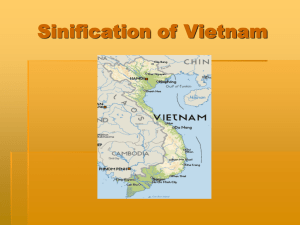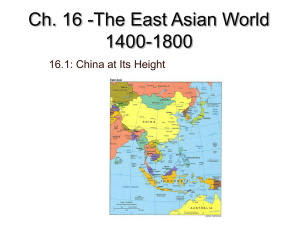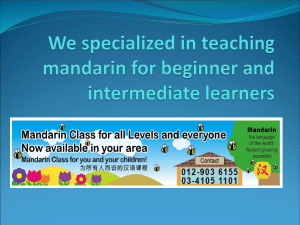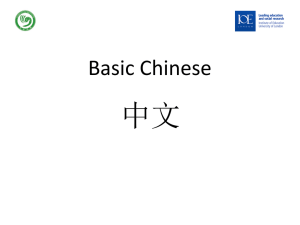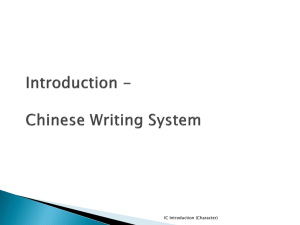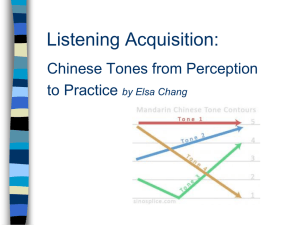Chinese Language
advertisement
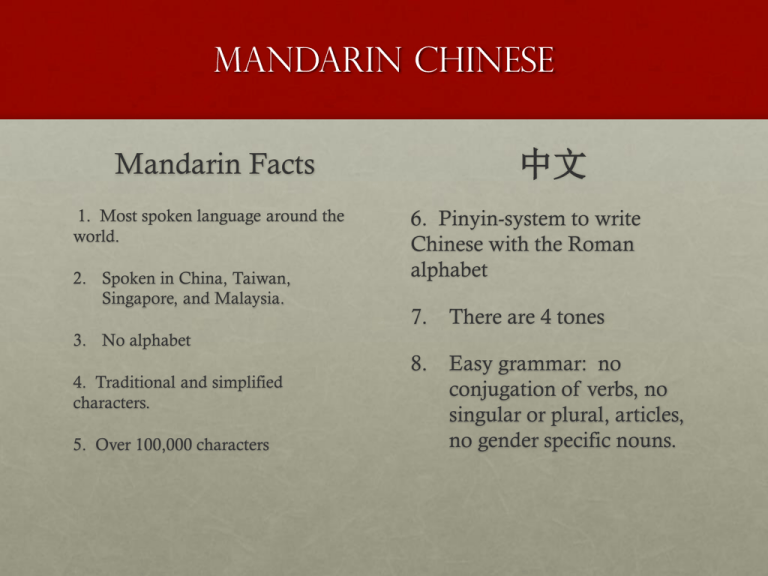
Mandarin Chinese Mandarin Facts 1. Most spoken language around the world. 2. Spoken in China, Taiwan, Singapore, and Malaysia. 中文 6. Pinyin-system to write Chinese with the Roman alphabet 7. There are 4 tones 8. Easy grammar: no conjugation of verbs, no singular or plural, articles, no gender specific nouns. 3. No alphabet 4. Traditional and simplified characters. 5. Over 100,000 characters Zhongwen, Zhongguohua, Putonghua, Guoyu, Hanyu Why learn Chinese? 1. Left side and right side of the brain. 2. Chinese characters increase IQ. 3. China’s economic rise 4. Learn about the culture Chinese Basics Pinyin 1. Romanization C=ts Q=ch X=sh Zh=j Other sounds can be be pronounced as they are written. Initials Chinese Basics Pinyin 1. Romanization Ai = long i EI = long a Ui = way Ao = ow Ou = long o Finals The 4 Tones Using “ma” Practice sounds and tones Chinese? Dialects 1. There are many dialects spoken in China. 2. Each province and even regions within provinces have their own local language. 3. Tulsa to NYC vs. Beijing to Hong Kong Mandarin How do the Chinese communicate? • Chinese characters! • Also, most Chinese have learned to speak Mandarin since it is the official language of China. Oracle Bones • People in China began writing around 1,500 BC. • Animal bones-shoulder of an ox and turtle shell • Priests could tell the future. • Strips of bamboo • Silk cloth • Paper-100 BC Hanzi 汉字 Characters 1. Chinese symbols 2. Pictograms 3. Traditional or Simplified 4. Over 50,000 characters 5. 3,000-5,000 to read a newspaper 6. Radicals Radicals Hanzi 汉字 How would you look up a Chinese character? 1. Number of strokes and the radical. 2. A radical is a classifier 3. 214 or 187 Radicals Why simplify? “One state, one people, one language.” • Chairman Mao implemented this change after the founding of the People’s Republic of China in 1949. • Language and literacy reforms in China opened peasants and workers to a better more sustainable life. • 80% could not read before 1949. Educational Reformer Traditional vs. Simplified • There is a debate over which characters should be used. • Traditional characters are learned in Taiwan, Hong Kong, and Singapore. • Which do you prefer? Characters Simple Characters All strokes Yong3 Forever Complex characters Zhe2-Talkative 64 strokes Biang2(Biao1biao1) noodles 58 strokes Chinese Basics Common Chinese Surnames The Book of Hundred Family Surnames (百家姓) Last name first 1. Over 10,000 surnames 2. 85% of the population has the top 100 surnames. 3. I can’t marry you! 5. 4. 6. 7. References • http://afe.easia.columbia.edu/tps/1000bce.htm#language • http://afe.easia.columbia.edu/special/china_1000bce_lang uage.htm • http://news.bbc.co.uk/2/hi/health/3025796.stm • “How Hand Writing Trains the Brain,” Journal October 2010 Wall Street • http://endphysics.com/chinese_characters_iq.html • honghua Xinshi Dachi dian 《中华姓氏大辞典》 (Great Dictionary of Chinese Surnames) by Yuan Yida (ISBN 7504114774)





